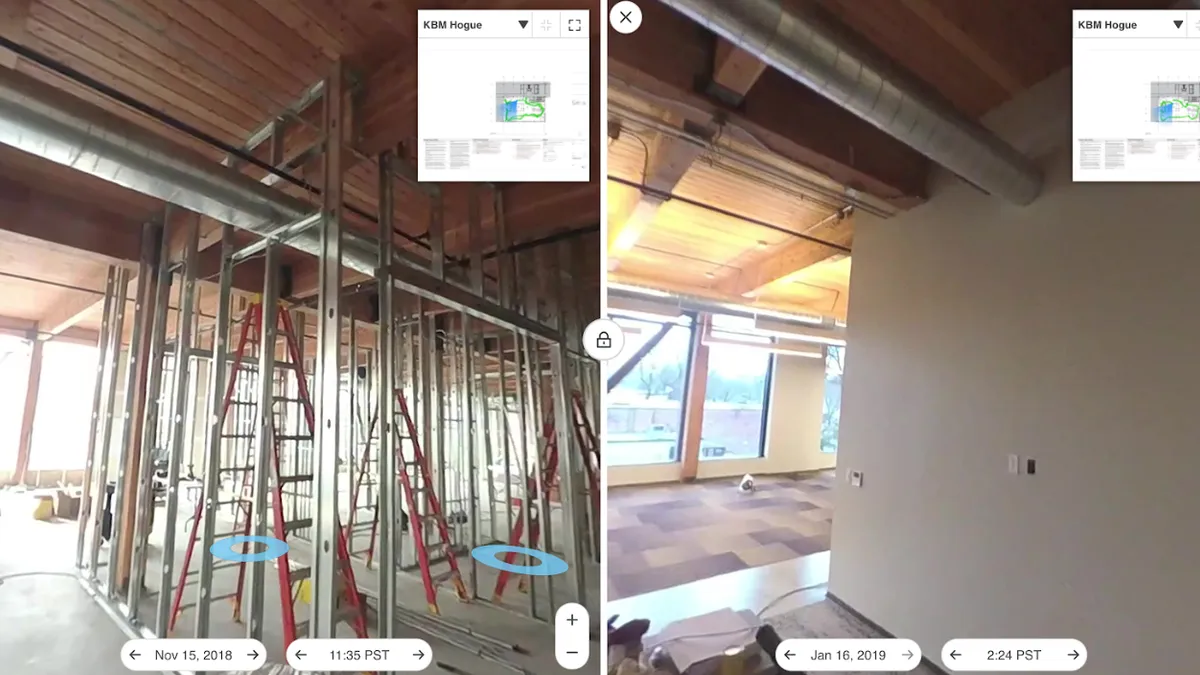A San Francisco-based construction tech startup that recently received a $14 million stamp of approval from investors is also impressing the construction managers who use its software.
OpenSpace, maker of an artificial intelligence-driven technology that captures and analyzes construction site data, received the capital infusion this summer. Investors include co-working giant WeWork as well as two well-known industry stalwarts with experience using the platform: Suffolk Construction and real estate developer Tishman Speyer.
The financing marks the company’s first raise since it closed on a $3.5 million seed round after its founding in September 2017.
The software uses artificial intelligence to create navigable, 360-degree photo representations of a site. To record the images, a builder attaches a small, off-the-shelf camera to his or her hardhat and walks the site as normal, with OpenSpace passively capturing imagery in the background.
Imagery data is then uploaded to the cloud, where algorithms map the photos to project plans and “stitch” them together, the company says, creating a visual representation of the site similar in style to Google Street View. Data generated by OpenSpace accumulates over time, allowing construction pros to review site conditions from days, weeks or years in the past. (See video animation below.) The software automatically pins the images to floor plans for easy navigation.
Suffolk Executive Vice President and Chief Data Officer Jit Kee Chin finds this automatic tagging the most compelling feature about OpenSpace, which she says the company has been rolling out for about a year.
“The utility of OpenSpace is its ease of use and the intelligence that autotags the images based on the floor plan, and with a timestamp,” she said.
The company piloted OpenSpace at a project in upstate New York and found it was very helpful for Suffolk managers to share updates with the client, who was based in New York City.
“The owners didn’t need to solely rely on our account because they could physically experience what it’s like to walk through the site without actually being there,” she said.
The software is especially helpful for capturing the interiors of high rise buildings, she said — something not easily done with drones. It allows project managers to easily communicate with subcontractors as well, she noted, because both parties can see instantaneously if there is an issue.
“It makes the conversation much easier,” she said. “There’s not really a debate about the information, so the team can focus the discussion around what to do about it.”
It’s also great for documenting what’s inside a wall before it’s filled in, she said, and the timestamp feature helps keep records organized chronologically.
"With so many current benefits to OpenSpace, a strong team and an exciting product roadmap," it was attractive for Suffolk to take part in the latest round of funding, she said.
“We started using it on one site and then scaled it to a couple more,” she said. “The potential of the technology quickly became apparent.”
'Crazy-positive feedback'
Menlo Park, California-based Novo Construction has used OpenSpace for nearly a year, on about 20 jobs nationwide. The 295-employee Novo, which also has offices in San Francisco and Austin, Texas, is primarily focused on tenant improvement, data centers, manufacturing and labs.
Novo COO Mike Ballou said the technology has been appreciated by clients like Google, Apple and Cisco that have multiple projects underway at one time. Instead of battling traffic to visit each site, customers log on to OpenSpace to get project updates.
Project stakeholders use OpenSpace to conduct virtual site tours, communicate easily about change orders and review the photo record to see changes over time, he told Construction Dive. Ballou agrees one of the biggest benefits of the program is seeing what’s behind the walls over time, as they are built out.
“I've had crazy positive feedback from building engineers that this is a game changer for them to know what’s in the walls, what’s in the ceiling,” he said.
Just before a job is closed, a Novo manager walks the site wearing a hardhat camera, Ballou said, recording the space for the client.
“We then make that video part of our closeout package,” he said. “That way facilities engineers can forevermore go back and look to see what’s in there in terms of things like plumbing, electrical and anything else.”
Novo safety managers located in Menlo Park are also using the technology to perform virtual job walks, saving the time and expenses related to traveling. The managers can view the videos remotely and provide feedback to superintendents. If a change is requested, the super walks the area again to show the task has been completed, Ballou said.
Going forward
In total, OpenSpace is currently being used on more than $50 billion worth of projects around the world, according to a company press release, including Tishman Speyer’s MIRA project in San Francisco and the Spiral, a 3 million-square-foot development in New York City.
Jenny Wong, managing director at Tishman Speyer, said in the press release the company sees value in scaling the program more broadly. Suffolk's Chin feels the same way about the technology's potential for the construction industry.
"As a construction management company, delivering a great experience to the owners we work with is a top priority and I think OpenSpace definitely helps us achieve that," she said.



















